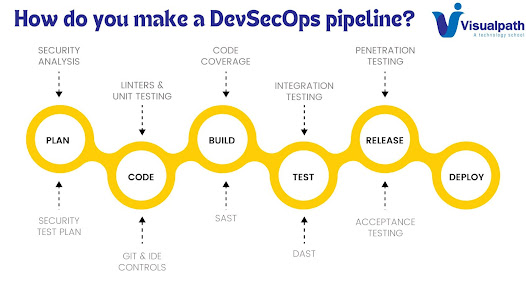- Get link
- X
- Other Apps
- Get link
- X
- Other Apps
DevSecOps is a methodology that integrates security practices into the DevOps framework, emphasizing collaboration between development, security, and operations teams to produce secure, reliable, and efficient software. Implementing a DevSecOps pipeline can significantly improve an organization's ability to deliver secure software faster.
1. Start with a
Security Culture:
Creating a successful
DevSecOps pipeline starts with fostering a security culture across the
organization. This involves educating teams on security best practices,
encouraging a proactive approach to identifying and addressing vulnerabilities,
and emphasizing the importance of secure coding practices. -DevSecOps Training
Online
2. Integrate
Security Tools and Automation:
Automating security
checks is essential for a seamless DevSecOps pipeline. Integrate security tools
at every stage of the software development lifecycle, including static
application security testing (SAST) and dynamic application security testing
(DAST) tools. These tools help catch vulnerabilities early in the process,
reducing the chance of security issues later on. -DevSecOps Training in
Ameerpet
3. Use
Infrastructure as Code (IaC):
Infrastructure as Code
allows for the automated creation, management, and deployment of infrastructure.
By treating infrastructure as code, you can ensure consistent and secure
deployment across different environments. Additionally, using security tools to
analyze IaC scripts can help identify potential vulnerabilities in the
infrastructure setup. -DevSecOps Training
Institute in Hyderabad
4. Implement
Continuous Security Monitoring:
Continuous security
monitoring is crucial to identify and address threats in real-time. Utilize
tools for monitoring application performance, system logs, and network traffic.
Alert the relevant teams to potential security breaches or vulnerabilities,
allowing for quick remediation. -AWS DevSecOps Training
5. Integrate Security Gates:
Security gates are checkpoints
in the DevSecOps pipeline where security and compliance checks must pass before
proceeding to the next stage. These gates help ensure that all code meets the
required security and compliance standards, reducing the risk of introducing
vulnerabilities into the production environment.
6. Ensure Secure
Coding Practices:
Training developers on
secure coding practices is essential for a successful DevSecOps pipeline.
Encourage the use of best practices such as input validation, output encoding,
and secure error handling. This minimizes the risk of introducing
vulnerabilities during development. -DevSecOps Course in
Hyderabad
7. Review and
Iterate:
Continuously assess and
improve your DevSecOps pipeline. Regularly review security practices, tools,
and processes to identify areas for improvement. Encourage feedback from all
teams involved in the pipeline to ensure that the process remains efficient and
effective. -DevSecOps Training in
Hyderabad
Conclusion:
A DevSecOps
pipeline helps organizations deliver secure and reliable software by
integrating security throughout the software development lifecycle. By
fostering a security culture, automating security checks, and continuously
reviewing and improving practices, organizations can achieve efficient and
secure software delivery. As with any process, ongoing iteration and
collaboration are key to ensuring the pipeline remains robust and effective.
Visualpath is the Best Software Online Training Institute in
Hyderabad. Avail complete AWS DevSecOps Online Training worldwide.
You will get the best course at an affordable cost.
Attend
Free Demo
Call on - +91-9989971070.
WhatsApp: https://www.whatsapp.com/catalog/919989971070
Visit: https://www.visualpath.in/aws-devsecops-online-training.html
AWSDevSecOpsOnlineTraining
AWSDevSecOpsTraining
AWSDevSecOpsTraininginAmeerpet
DevSecOpsCourseinHyderabad
DevSecOpsTraining InstituteinHyderabad
DevSecOpsTraininginHyderabad
DevSecOpsTrainingOnline
- Get link
- X
- Other Apps

Comments
Post a Comment